When creating or editing a course, scroll down to Course Builder, and click + Quiz under one of your Topics to start building your quiz.

Quiz Info #
This will open the Quiz Builder window with its very first section called Quiz Info. Give the quiz a Title and a summary to let students know what the quiz is about:
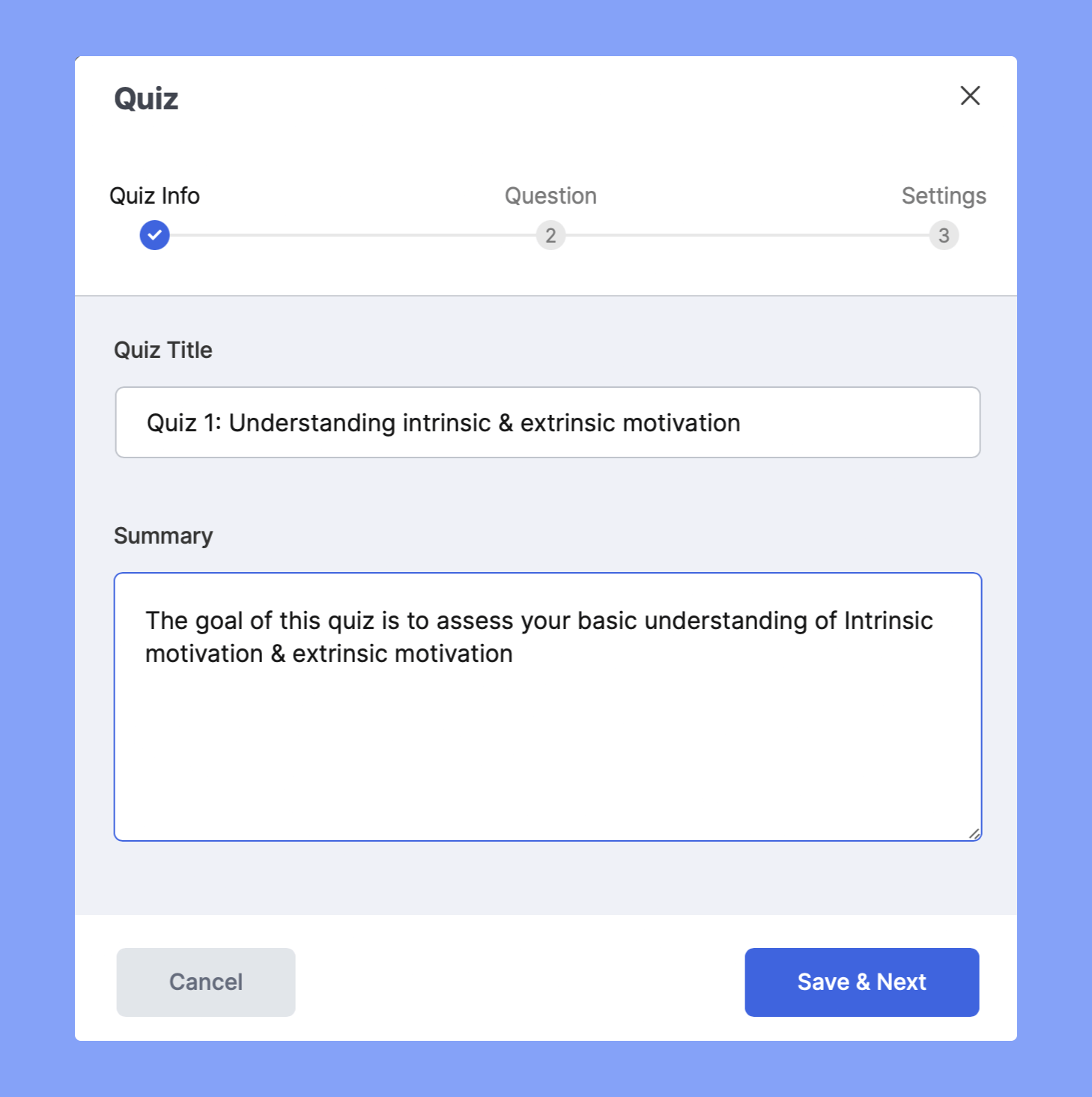
To start adding questions and answers, simply click on the Save & Next button.
Question Types #
Start adding questions to the quiz by clicking on the Add Question button, then begin by selecting the Question Type.
There are a total of 10 question types. Below is a list of what these types are as well as an explanation of how they work.
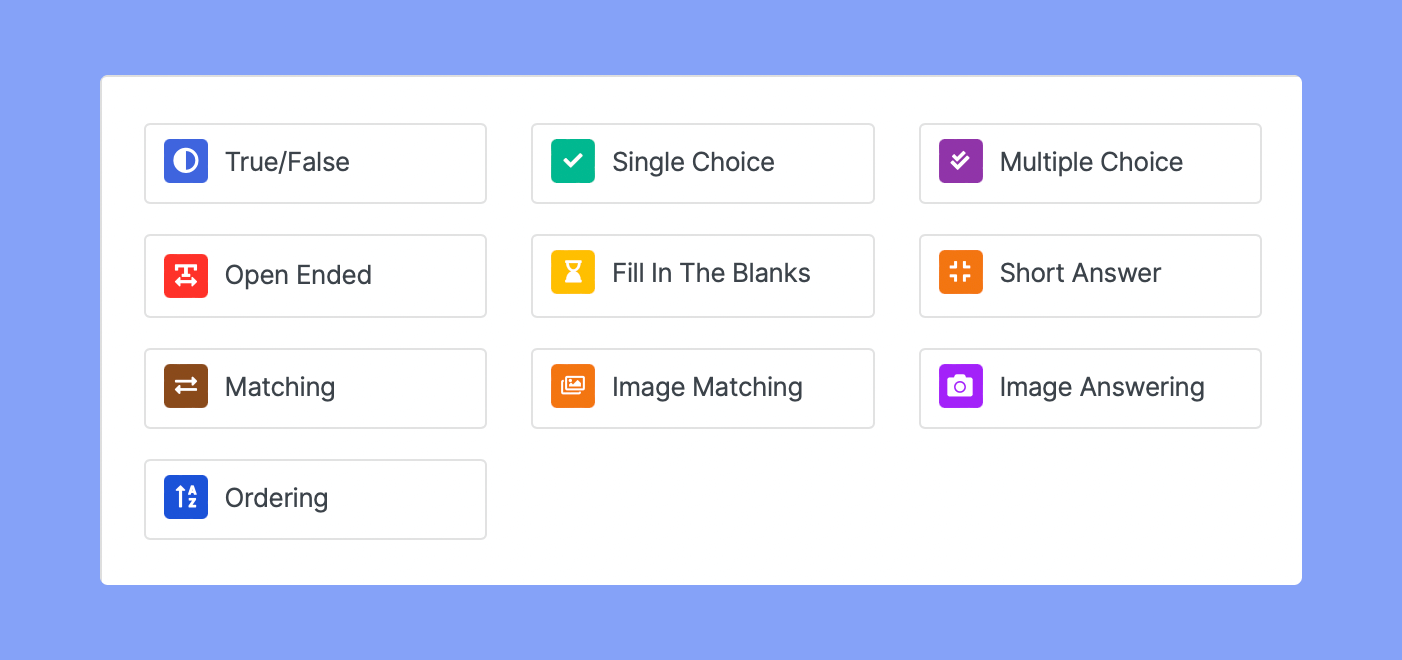
1. True/False #
To set up a true/false question, first select your question type as True/False. Write your question at the top of the window, then choose if ‘true’ or ‘false’ is the correct answer:
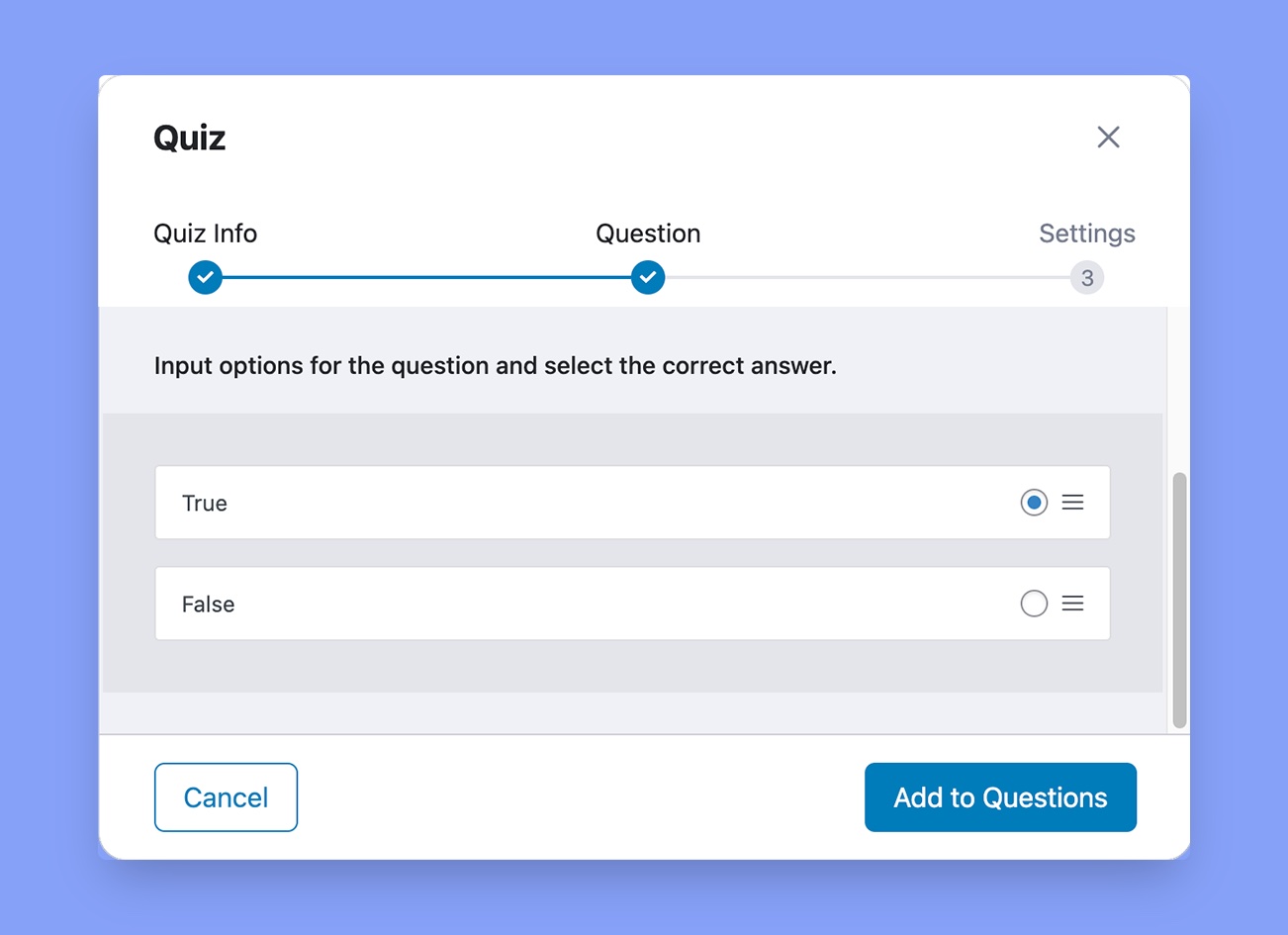
2. Single Choice #
Use the single-choice quiz format if you want to use a multiple-choice question with only one correct answer. To add the answer options, click on Add an Option and define the answer in the ‘Answer Title’, upload an image if needed, and select the display format of your choice.
Finally, click on Update Answer and repeat these steps for the other options. Don’t forget to specify the correct answer at the end.
3. Multiple Choice #
The multiple-choice question is similar to the single-choice question. If you want to list multiple correct answers for a single question, choose the multiple-choice option. Students will get full marks only if they select all of the right answers while answering the question.
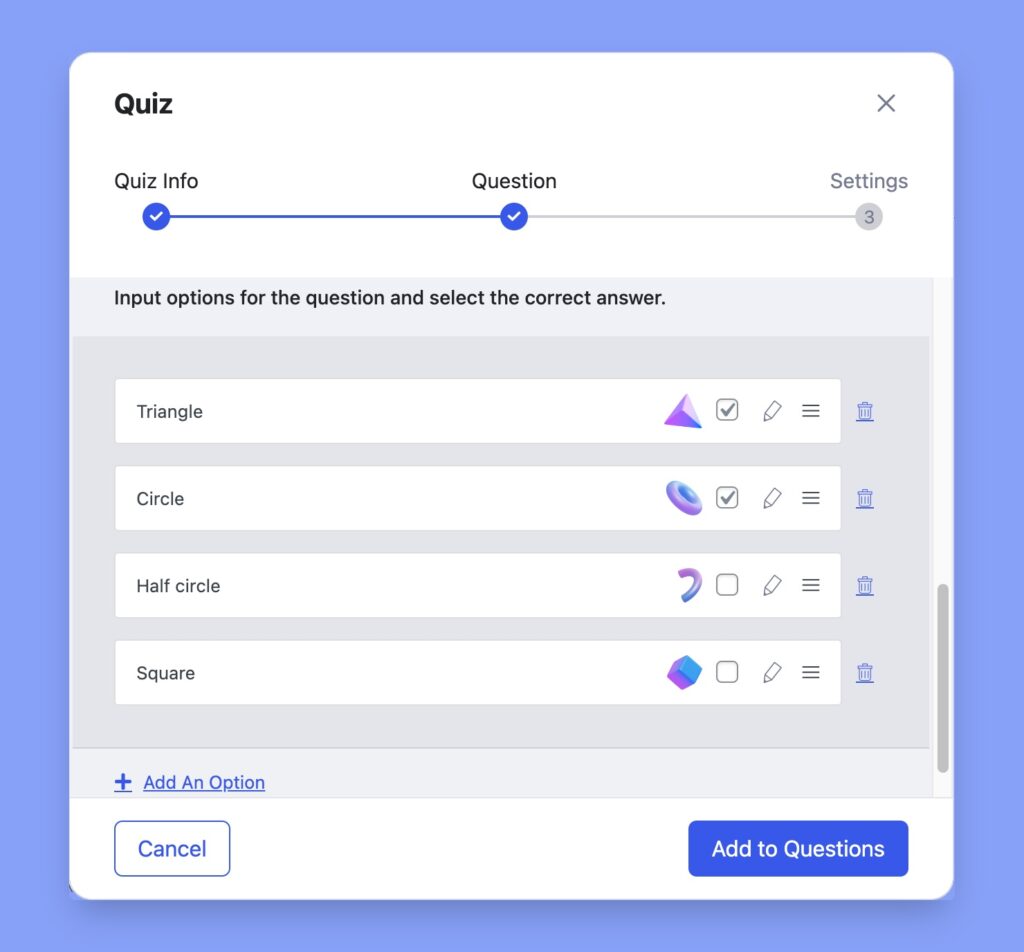
4. Open-Ended #
A long answer question type where students can give descriptive answers, as this field can have a larger character limit.
You can define this character limit on the Settings page of your quiz, by adding your Questions, and clicking Save & Next which will take you to the page below. Under Advanced Settings, you’ll see the Open-Ended/Essay questions answer character limit field.
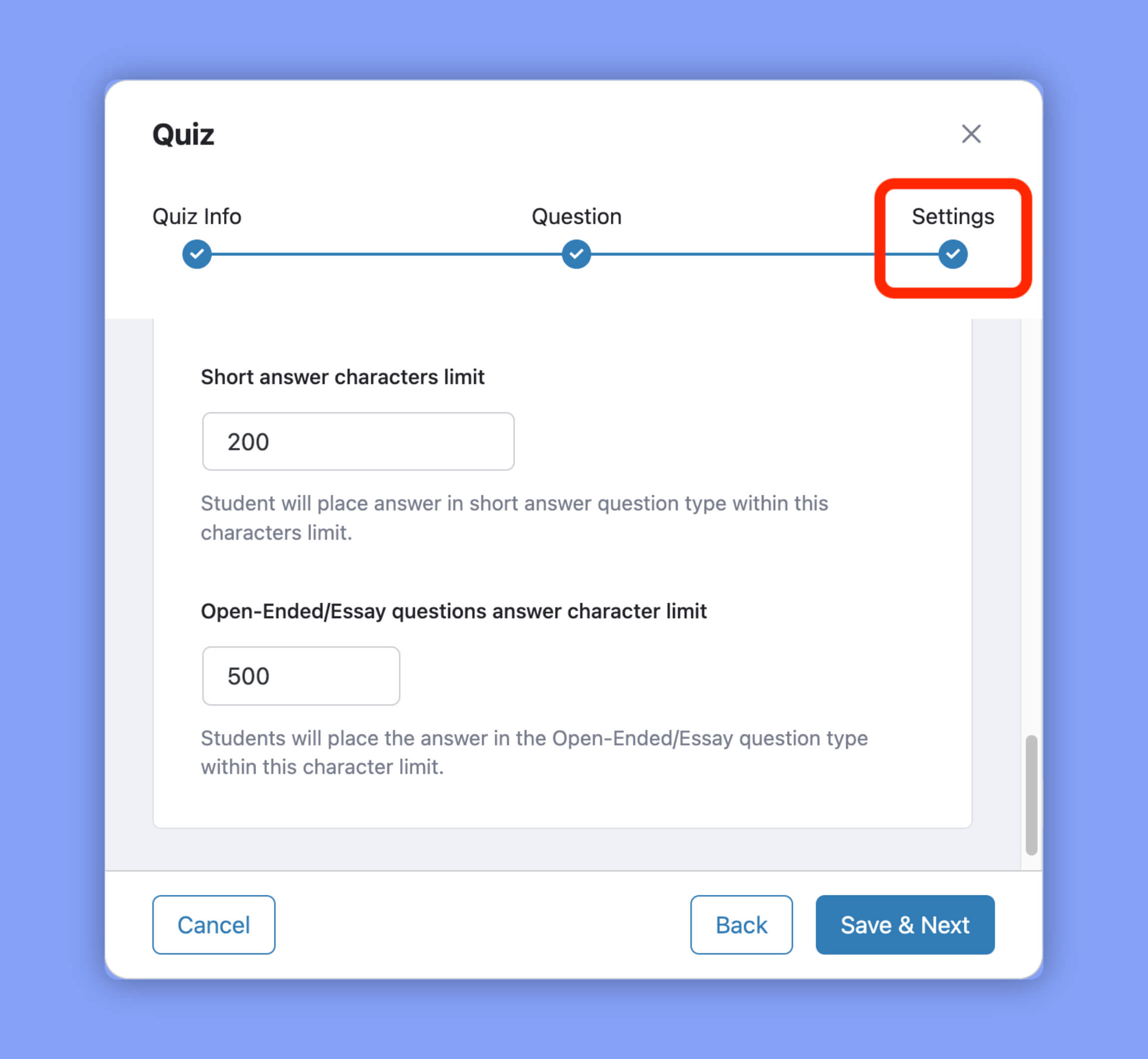
5. Short Answer #
A Descriptive-type question with a more precise and shorter answer than the Open-Ended type. You can define the character limit in the same way as above, under the Short answer characters limit in the Settings section.
6. Fill In The Blanks #
Set a sentence prompting students to fill up the missing blanks with the correct answers.
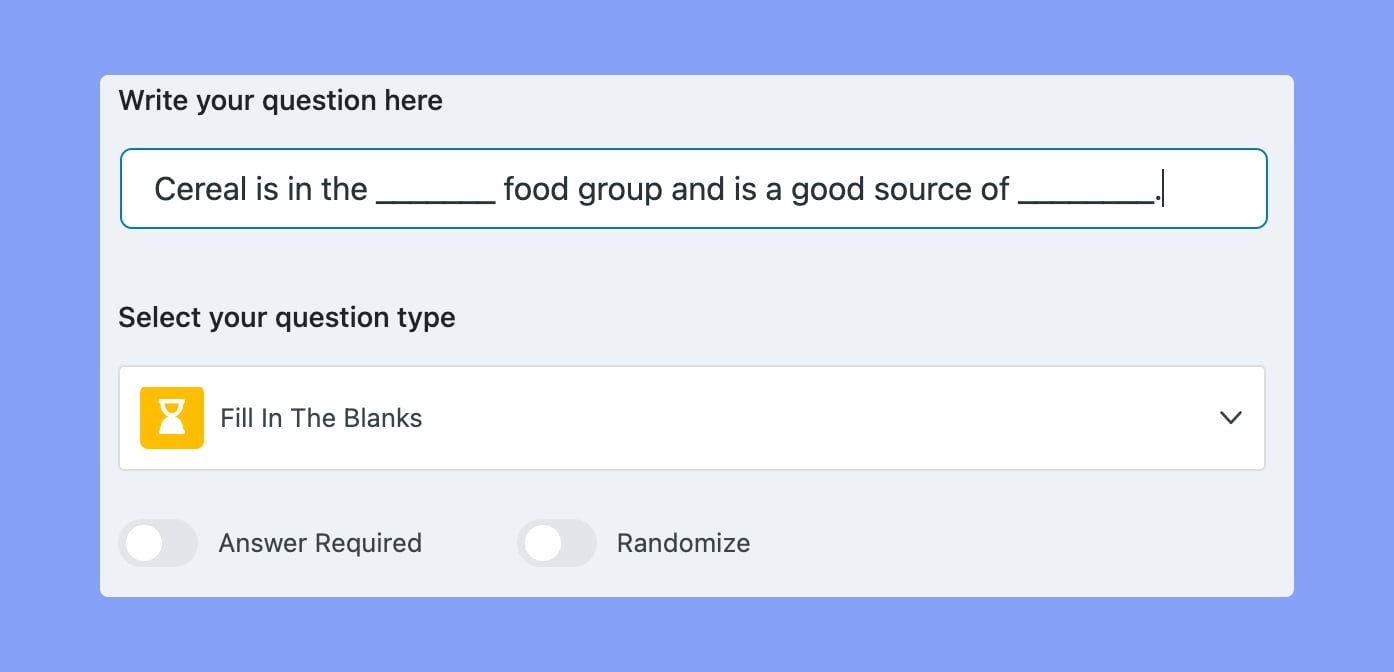
First, enter the question and then click on Add an Option.
Type your question or statement under Question Title and replace the blanks with the variable {dash}. Below that field, define your Correct Answers each separated by a vertical bar |.
Here’s an example:
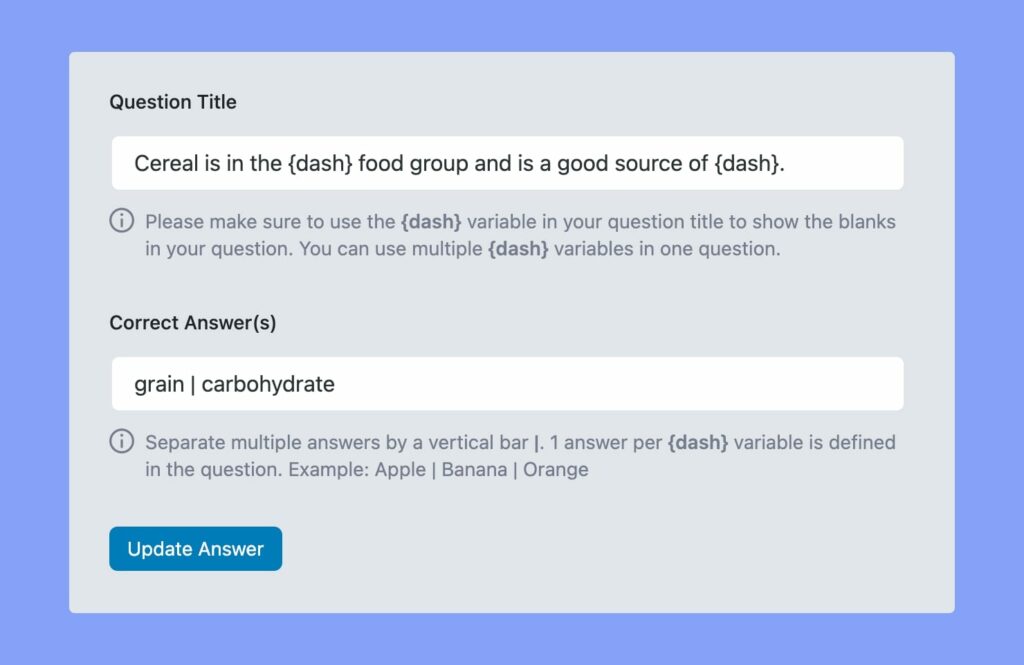
Students will see something like this when they take the quiz:
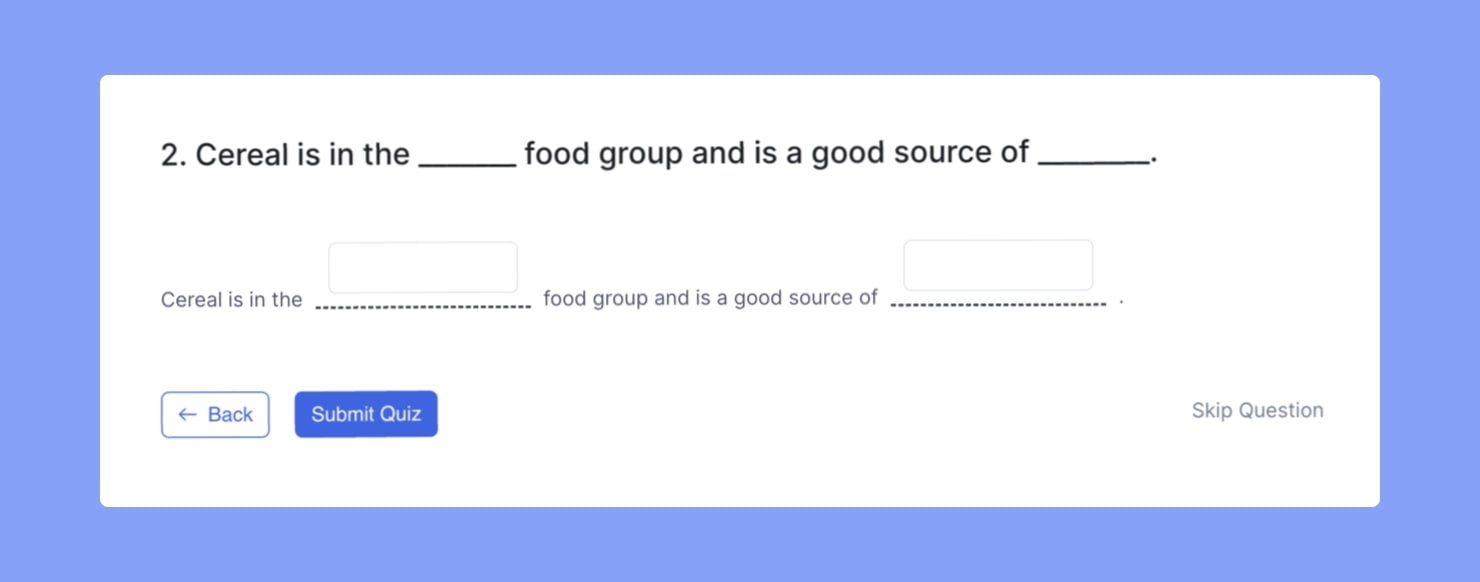
7. Matching #
Use this type of question only if you want to set a question where students have to match the answers. To do this, enter your question and click on Add an Option. Enter your answer prompt and its matched answer.
You can also upload an image along with the answer prompt. Finally, select the display format you prefer and repeat these steps to add more options.
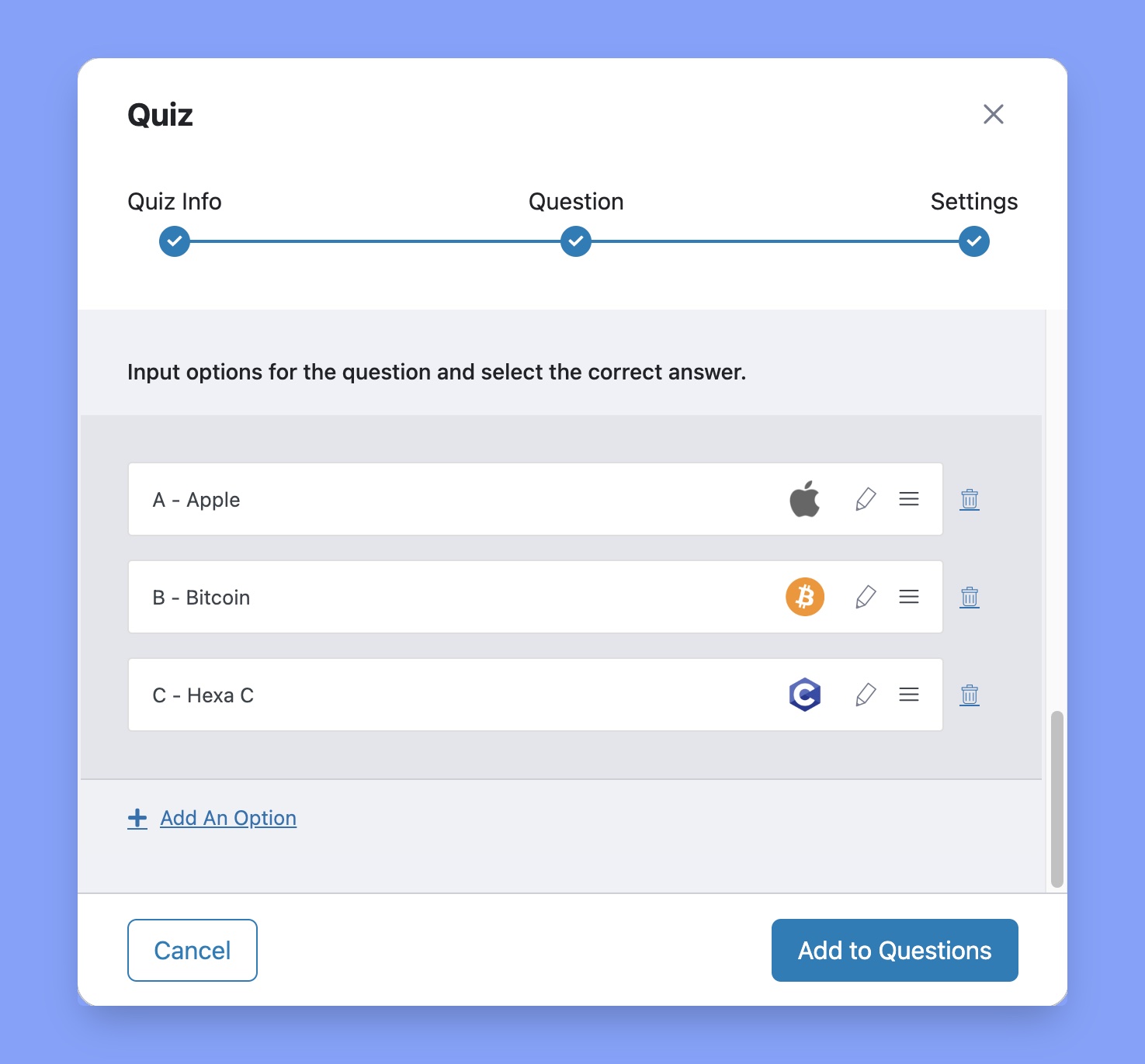
8. Ordering #
Students have to reorder the given text, images, or both in the correct sequence to get a correct answer.
Click on Add an Option and enter your first answer item under the Answer Title field. Like the previous question types, you can also upload an image. Repeat these steps to add more items and make sure to add them in the right order.

9. Image Matching #
Students can match an image to the correct text to get a correct answer. Click on Add an Option and upload your image, enter its matched answer, and click on Update Answer. Repeat these steps to add more options.
10. Image Answering #
Students answer questions based on images. Similar to Image Matching, click on Add an Option and upload your image, and then enter its corresponding answer. Lastly, click on Update Answer and repeat these steps to add more options.
Question Description (Optional) #
You can add text formatting, images, videos, and more to your quiz question descriptions. For example:
- Text styling like bold, italics, underlines, text color, etc
- Bullet points and numbered lists
- Hyperlinks
- Images and videos via embed codes or URL links
- Audio files like podcasts via embed codes
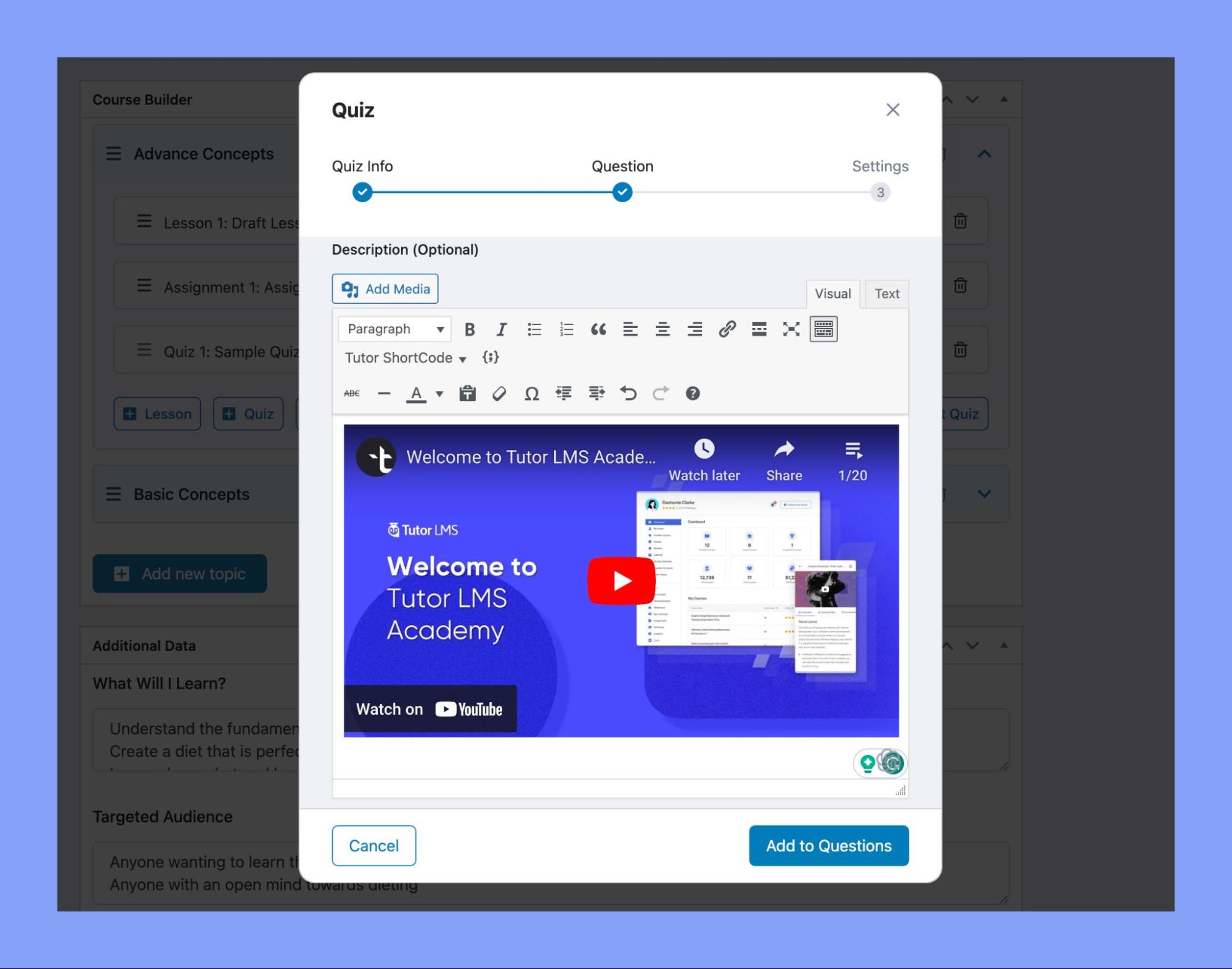
Answer Explanation (Optional) #
Here you can explain to help students understand the correct answers and the reasoning behind them:
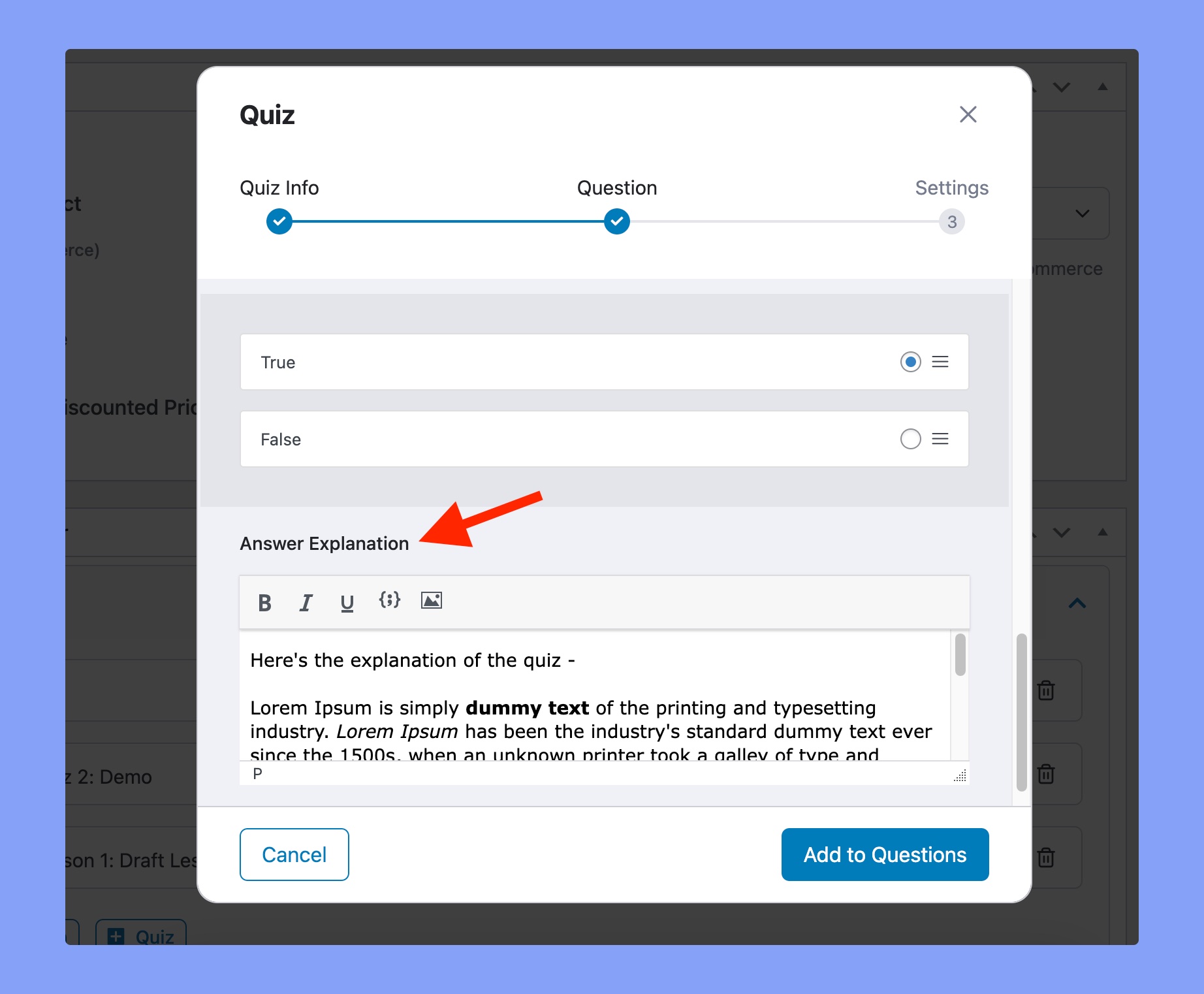
Students can access the explanation from the Quiz Details page after they’ve taken the quiz. Here’s a preview of the quiz explanation:

Quiz & Question Settings #
There are a few settings for each individual question – here’s what they mean:
- Answer Required: Toggle this if you want this question to be mandatory to answer.
- Randomize: Toggle this if you want this question’s order to be randomly shuffled among the list of questions.
- Points for this answer: Use this field to set the points to be awarded for getting this question right.
- Display points: Enable this if you want to display the points on the quiz field.
Here are additional settings for the entire quiz:
Time Limit #
You can set time limit from here in seconds, minutes, hours, days, and weeks format. Use 0 if you don’t want to set any time limit.
You can also hide the quiz time by toggling the Hide quiz time button.

Quiz Feedback Mode #
Decide how you want to provide your students with feedback after they are done taking the quiz. Here, you’ll get three different feedback modes. These are:
- Default: Answers are displayed after the quiz is finished.
- Reveal Mode: Answers are shown after the attempt.
- Retry Mode: Reattempt the quiz any number of times. You can define the number of times students can repeat a quiz using the Attempts Allowed setting.
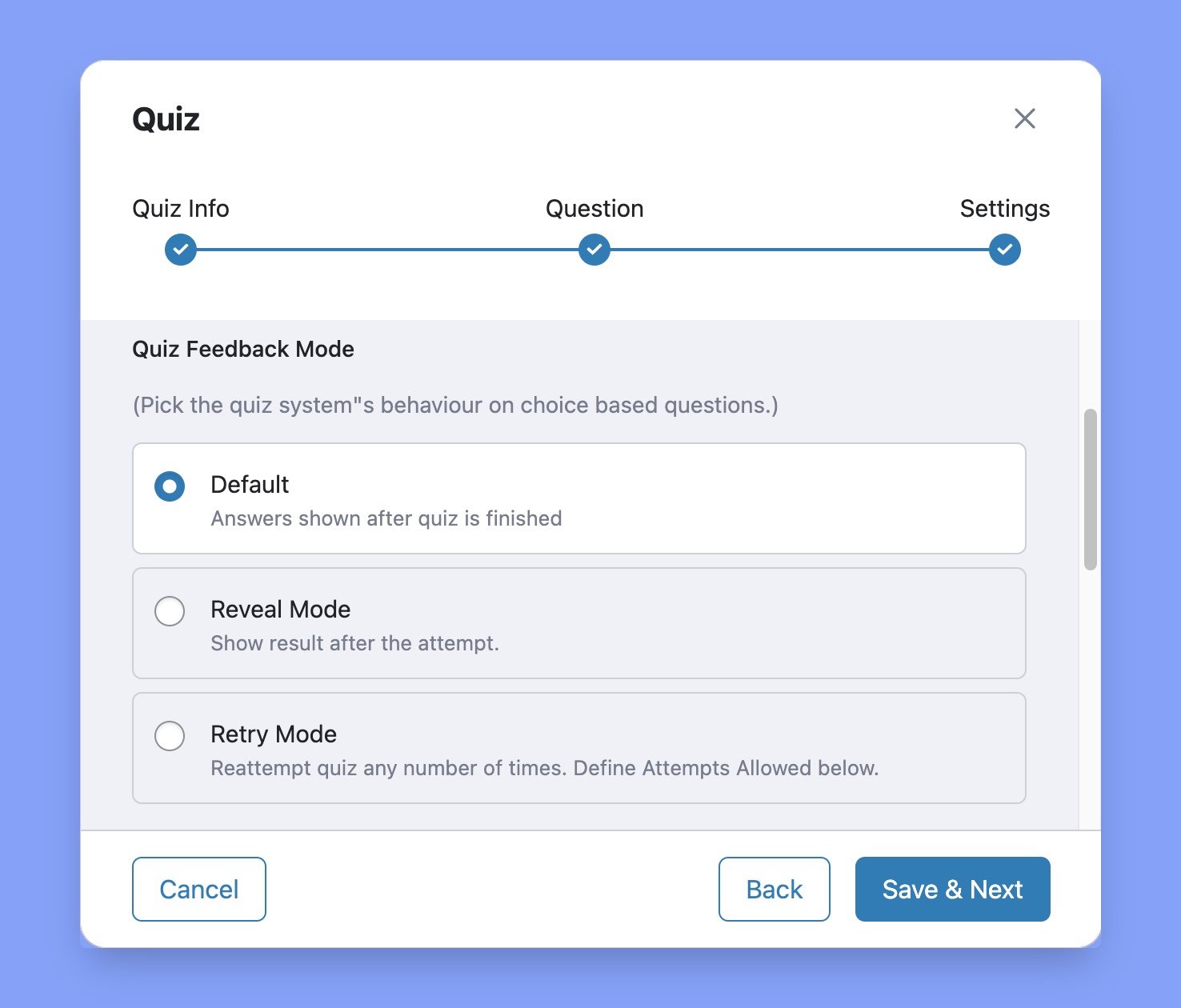
Passing grade #
Specifies the passing grade for this quiz. You can set the passing grade only in the percentage unit (see image below).
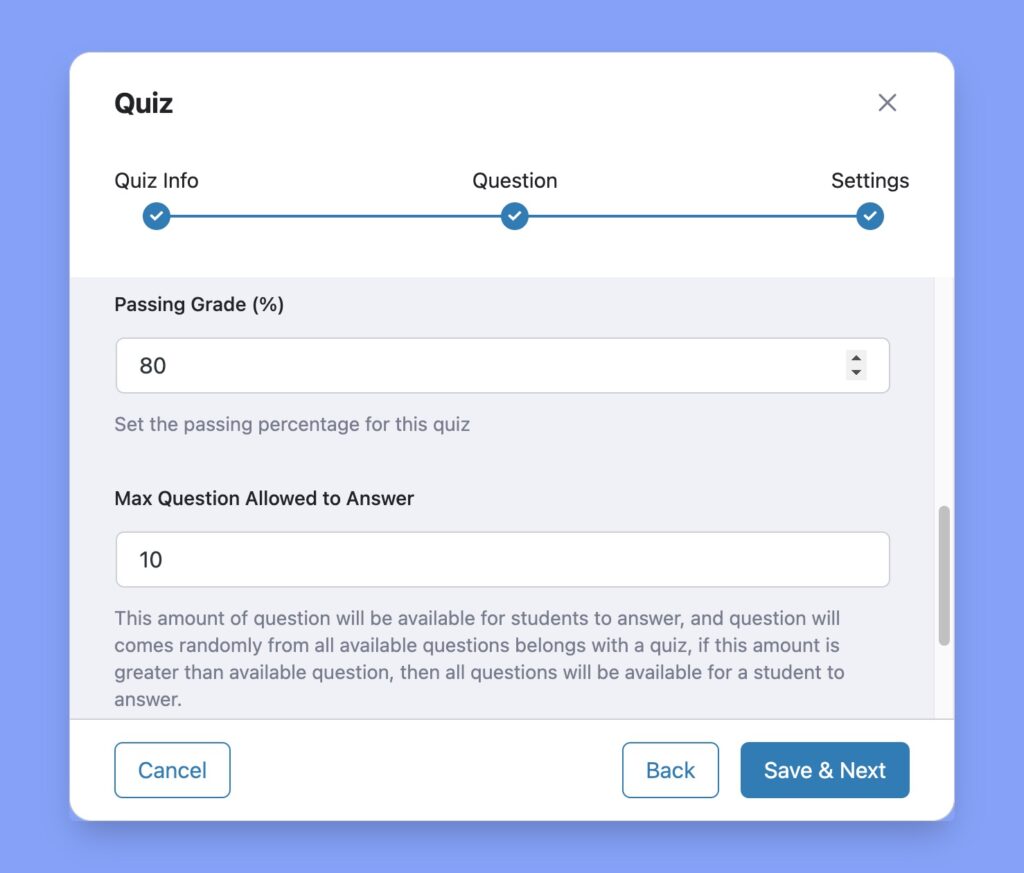
Max Question Allowed to Answer #
This feature is to randomize questions in a quiz (see the above image). Here is an example:
Let’s say you have 20 questions in a quiz. If you put 20 here, a student will have to answer all 20 questions to complete the quiz. But if you put 10 here, the student will have to answer only 10 questions out of the 20, and these 10 questions will appear randomly. No student will get the same set of questions.
Advanced Settings #
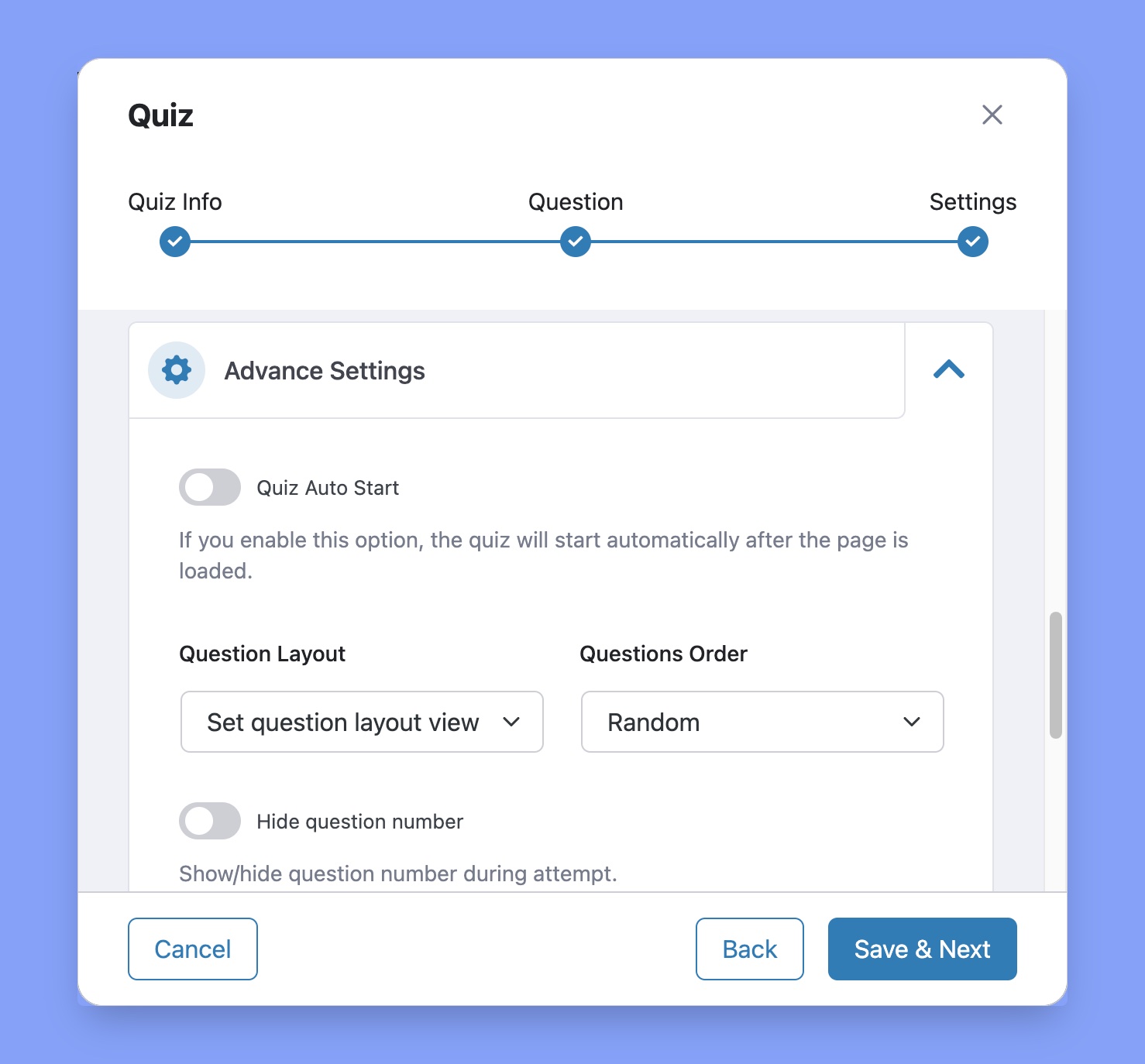
More Advanced Settings options that you can access by clicking on the Advanced Settings header.
- Quiz Auto Start: Enable this to make the quiz start immediately after the page is loaded.
- Question Layout: Set the layout for the quiz page. Options include Single Question, Pagination, and Question below the other.
- Question Order: Select the order for the questions provided to you. Options include Random, Sorting, Ascending, and Descending.
- Hide Question Number: Select to hide the question number during the quiz.
- Short Answer Character Limit: Select the character limit for short answers.
- Open-ended/Essay Question Answer Character Limit: Select the character limit for open-ended/essay question answers.
Finally, once you’re satisfied with the settings click on Save & Next again to save your quiz. It should appear under your chosen topic on the Course Builder.
To Edit the quiz, click on the edit icon that’s on the right side of the quiz listing, and to Delete it, click on the trash icon that’s right beside it.
Require Passing Quiz to Access Next Course Topic (Optional) #
Make it mandatory for students to pass a quiz to access the next course contents.
- On the Course Builder page, under Course Settings, enable “Content Drip” and set its type to Course content available sequentially.
- Update the course to ensure this change is applied.
- Next, from Quiz Builder > Settings set the Quiz Feedback Mode as Retry Mode.
- You should see the Passing is Required toggle appear below the “Attempts Allowed” slider. Enable this option, click on Save & Next, and Update your course to save the changes.
It’s now mandatory for your students to pass this quiz to access the course material that follows!
Note: If a quiz contains any open-ended questions that require the instructor’s (your) review, the next course content will only be available after the instructor (you) does so.
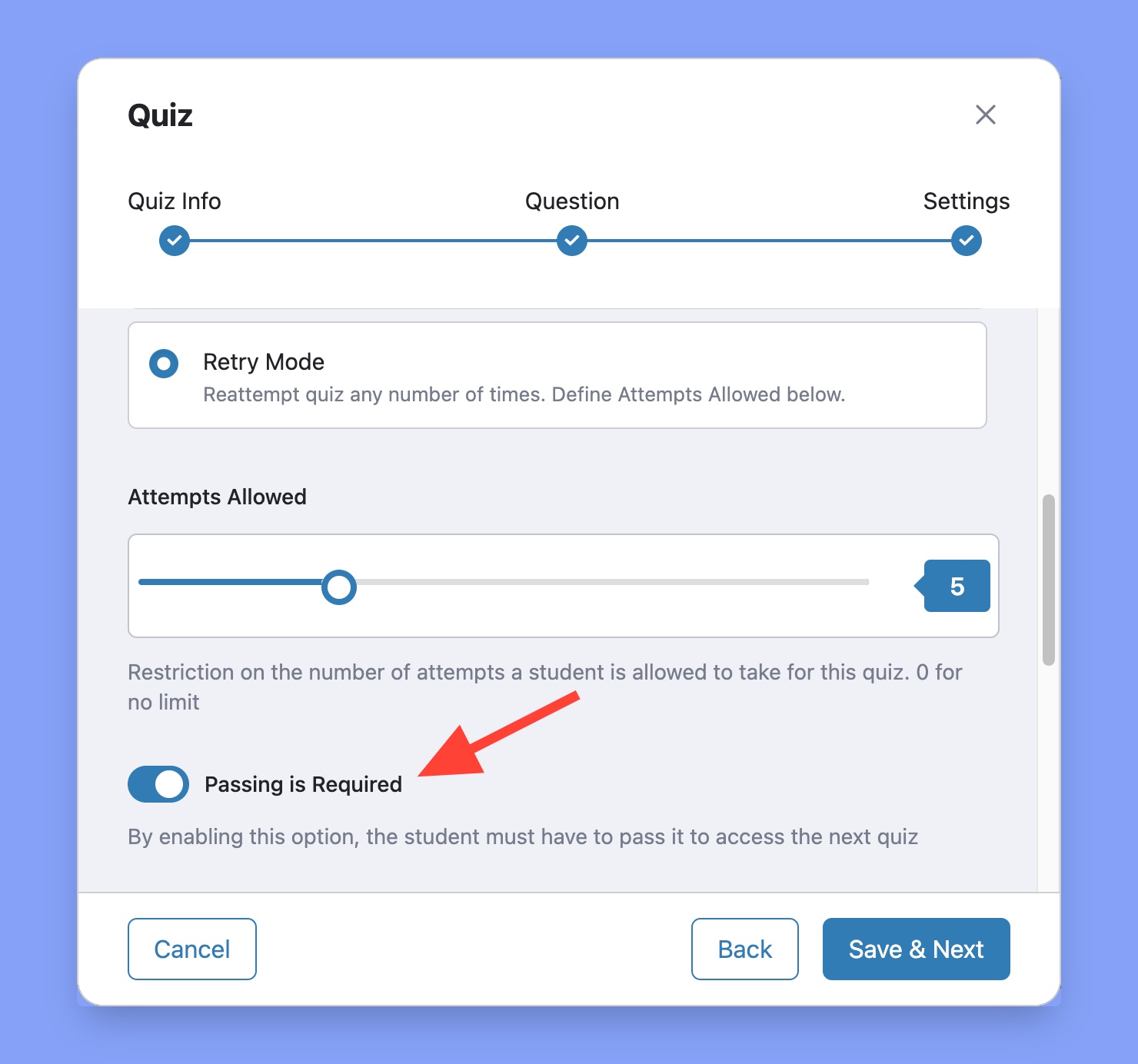
If they fail a quiz that requires passing and attempt to access the next lesson, they’ll now get a message like this:

